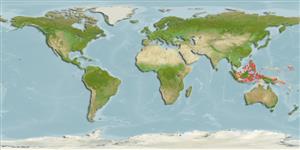Common names from other countries
>
Gobiiformes (Gobies) >
Gobiidae (Gobies) > Gobiinae
Etymology: Amblygobius: Greek, amblys = darkness + Latin gobius = gudgeon (Ref. 45335).
More on author: Herre.
Environment: milieu / climate zone / depth range / distribution range
Écologie
marin récifal; profondeur 0 - 15 m (Ref. 48637), usually 0 - 4 m (Ref. 90102). Tropical
Western Pacific: southern Philippines to Java, Indonesia. Palau in Micronesia.
Taille / Poids / Âge
Maturity: Lm ? range ? - ? cm
Max length : 7.5 cm SL mâle / non sexé; (Ref. 48637)
Épines dorsales (Total): 6 - 7; Rayons mous dorsaux (Total): 14; Épines anales 1; Rayons mous anaux: 13. Characterized by presence of three grey to reddish stripes on upper two-thirds of body, interspersed with irregular red marking; lower side of body with five diffuse dark grey blotches; dark brown spot at caudal fin base; first and second dorsal fin equal in height; rounded caudal fin; longitudinal scale series 55-60; predorsal scales 22-25; scales dorsally on opercle, none on cheek; ctenoid body scales; cycloid scales on nape, abdomen and opercle; depth of body 4.5 in SL (Ref. 90102).
Found in silty inner tidal flats near mangroves and among seagrasses, usually hovering a little above the bottom (Ref. 34765). Feeds on small invertebrates and organic matter (Ref. 34765).
Life cycle and mating behavior
Maturité | Reproduction | Frai | Œufs | Fécondité | Larves
Myers, R.F., 1999. Micronesian reef fishes. A comprehensive guide to the coral reef fishes of Micronesia. Coral Graphics, Barrigada, Guam. 216 p. (Ref. 34765)
Statut dans la liste rouge de l'IUCN (Ref. 130435)
CITES (Ref. 128078)
Not Evaluated
Menace pour l'homme
Harmless
Utilisations par l'homme
Plus d'informations
Noms communsSynonymesMétabolismePrédateursÉcotoxicologieReproductionMaturitéFraiFéconditéŒufsDéveloppement de l'œuf
RéférencesAquacultureProfil d'aquacultureSouchesGénétiqueElectrophoresesHéritabilitéPathologiesTraitementMass conversion
CollaborateursImagesStamps, Coins Misc.SonsCiguateraVitesseType de nageSurface branchialeOtolithesCerveauxVision
Outils
Articles particuliers
Télécharger en XML
Sources Internet
Estimates based on models
Preferred temperature (Ref.
115969): 28.7 - 29.5, mean 29 (based on 602 cells).
Phylogenetic diversity index (Ref.
82804): PD
50 = 0.5000 [Uniqueness, from 0.5 = low to 2.0 = high].
Bayesian length-weight: a=0.01023 (0.00477 - 0.02194), b=3.02 (2.84 - 3.20), in cm Total Length, based on LWR estimates for this (Sub)family-body shape (Ref.
93245).
Niveau trophique (Ref.
69278): 2.7 ±0.24 se; based on food items.
Résilience (Ref.
120179): Haut, temps minimum de doublement de population inférieur à 15 mois (Preliminary K or Fecundity.).
Fishing Vulnerability (Ref.
59153): Low vulnerability (10 of 100).
